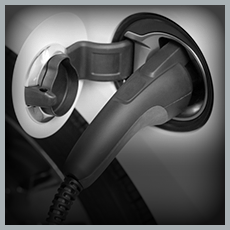OVERVIEW
Some of America’s earliest vehicles were powered by electricity, before automakers moved toward internal combustion engines that relied on cheap and convenient petroleum fuels. Over a century later, combustion engine vehicles dominate the market and petroleum accounts for all but one-tenth of 1% of energy consumed by highway vehicles.1 However, the need for more sustainable transportation has led to a global resurgence of interest in the electric vehicle (EV). Many analysts now see increased U.S. market penetration of EVs as inevitable,2 especially given aggressive new fuel-efficiency and GHG emissions standards,3 continued volatility of oil prices,4 and the declining cost of battery technology.5 But like any new technology, EVs face several barriers to widespread adoption.
ANALYSIS
Despite recent increases in domestic oil production, the U.S. still imports 3.8 billion barrels each year6 at a cost of $379 billion.7 Increasing the number of vehicles powered by domestically produced electricity would keep more energy investments and jobs within our borders. Under the right circumstances, EVs could also provide an economic benefit to purchasers—since charging an EV is already cheaper for drivers than fueling a traditional combustion engine vehicle.8 These savings will increase further if the price of gasoline rises and the price of battery technology continues to fall.9
While emissions vary based on the type of vehicle and the source of the power used for charging,10 the average EV produces 86% less NOx and 34% less greenhouse gas emissions per mile than the average combustion engine vehicle.11 EVs can help balance the intermittency of technologies like wind and solar power and reduce the cost of integrating them into the grid. Greater EV penetration would aid America’s transition to cleaner electricity sources.12
Some detractors claim that slow sales of “plug-in”13 EV models introduced in late 2010 indicate the failure of this technology.14 Yet the market history of hybrid vehicles offers a very different outlook. Led by the Toyota Prius, hybrids had limited sales when they were introduced to U.S. consumers in 2000. But sales have grown steadily, with nearly 269,000 hybrid vehicles sold in 2011.15 Early sales of today’s plug-in EVs have met or exceeded those of the Prius,16 suggesting that EVs have equal potential for success.17 The modern EV market started in the mid-2000s with just a few high-priced models from startup auto manufactures before Chevrolet and Nissan entered the market with the Volt and the Leaf, respectively.18 By the end of 2012, 13 EV models were available in the U.S. market with another 14 expected to be rolled-out by 2014.19
EVs will have to clear multiple hurdles before they capture a substantial share of the market. The greatest challenge to EV deployment is cost. Even with a federal tax credit of up to $7,500, today’s EVs still have a higher sticker price than comparable combustion engine models.20 This price disparity can be traced almost entirely to the battery, which comprises 35-45% of the total cost of an EV.21 Some manufacturers have begun leasing batteries separately from the vehicle, which could make EVs a more affordable option for American drivers.22 But this type of financing mechanism is unlikely to become widespread in the U.S. without additional data on EV usage and residual battery value.
Even as EVs decrease in price, Americans will need to be confident that an electric vehicle can meet their transportation needs before they are willing to purchase one. For instance, potential EV purchasers commonly express a desire for an enhanced network of public chargers (to supplement home charging) before they could be convinced to buy an EV.23 But there are not enough EVs within most cities or regions to support investment in charging infrastructure, creating a classic “chicken and egg” problem.
IMPLEMENTATION
To accelerate the deployment of EVs, federal policy should be used to lower the upfront cost of vehicles and increase the availability of charging infrastructure.






